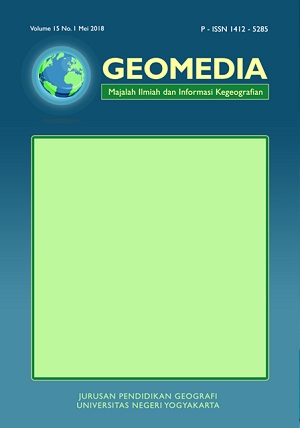Perkembangan Lahan Terbangun Kota Pekanbaru Tahun 2000-2020
DOI:
https://doi.org/10.21831/gm.v21i2.65372Keywords:
built up area, landsat, non built up area, urban sprawlAbstract
References
Almegi, A., & Eizlan, M. (2023). Pengaruh Keberadaan Kampus terhadap Perkembangan Lahan Terbangun di Wilayah Pinggiran Kota Pekanbaru. Media Komunikasi Geografi, 24(1), 15–28.
Arifin, S., Mukhoriyah, N., & Yudhatama, D. (2018). Analysis of Land Use Spatial Pattern Change of Town Development Using Remote Sensing. International Journal of Remote Sensing and Earth Sciences (IJReSES), 15(1), 93. https://doi.org/10.30536/j.ijreses.2018.v15.a2795
Blaschke, T. (2010). Object based image analysis for remote sensing. ISPRS Journal of Photogrammetry and Remote Sensing, 65(1), 2–16.
BPSa. (2022). Kota Pekanbaru Dalam Angka 2021. Badan Pusat Statistik Kota Pekanbaru
BPSb. (2021). Kecamatan Tampan Dalam Angka 2020. Badan Pusat Statistik Kota Pekanbaru
Hidajat, J. T., Sitorus, S. R. P., Rustiadi, E., & Machfud. (2013). Dinamika Pertumbuhan dan Status Keberlanjutan Kawasan Permukiman di Pinggiran Kota wilayah Metropolitan Jakarta. Majalah Globe Volume 15 No,1 Juni 2013, 1, 93–100.
Juliadi, R. S., Mardiana, & Tampubolon, D. (2021). Analisis Aspek Ekonomi Dan Sosial Kota Pekanbaru Sebagai Kota Layak Huni. Revenue : Jurnal Ekonomi Pembangunan Dan Ekonomi Islam, 4(02), 1–15. https://doi.org/10.56998/jr.v4i02.36
Mahendra, Y. I., & Pradoto, W. (2016). Transformasi Spasial di Kawasan Peri Urban Kota Malang. Jurnal Pembangunan Wilayah Dan Kota, 12(1), 122–126.
PP No. 13. (2017). Peraturan Pemerintah Republik Indonesia Nomor 13 Tahun 2017 tentang Perubahan Atas Peraturan Pemerintah Nomor 26 Tahun 2oo8 Tentang Rencana Tata Ruang Wilayah Nasional. 75.
Prasetyo, A. (2016). Pola Spasial Penjalaran Perkotaan Bodetabek: Studi Aplikasi Model Shannon's Entropy. Jurnal Geografi Gea, 16(2), 144–160.
Putra, D. R., & Pradoto, W. (2016). Pola Dan Faktor Perkembangan Pemanfaatan Lahan Di Kecamatan Mranggen, Kabupaten Demak. Jurnal Pengembangan Kota, 4(1), 67. https://doi.org/10.14710/jpk.4.1.67-75
Salihin, I., Akbar, L. O. N., & Jaya, G. (2018). Analisis Perubahan Tingkat Kepadatan Lahan Terbangun Kota Kendari Berdasarkan Indeks Lahan Terbangun. Jurnal Geografi Aplikasi Dan Teknologi, 2(2), 1–10.
Shi, G., Ye, P., Ding, L., Quinones, A., Li, Y., & Jiang, N. (2019). Spatio-temporal patterns of land use and cover change from 1990 to 2010: A case study of jiangsu province, China. International Journal of Environmental Research and Public Health, 16(6). https://doi.org/10.3390/ijerph16060907
Sipayung, M. C., Sudarsono, B., & Awwaluddin, M. (2019). Analisis Perubahan Lahan Untuk Melihat Arah Perkembangan Wilayah Menggunakan Sistem Informasi Geografis (Studi Kasus: Kota Medan). Jurnal Geodesi Undip, 9(1), 373–382.
Yunus, H. S. (2012). Struktur Tata Ruang Kota. Cetakan IX. Yogyakarta: Pustaka Pelajar.
Zahrotunisa, S., & Wicaksono, P. (2017). Prediksi Spasial Perkembangan Lahan Terbangun Melalui Pemanfaatan Citra Landsat Multitemporal di Kota Bogor. Diterima: 22 Juni, 2(1). https://join.if.uinsgd.ac.id/index.php/join/article/view/v2i16
Downloads
Published
How to Cite
Issue
Section
Citation Check
License
Authors who publish in this journal agree to the following terms:
- Authors retain copyright and grant the journal the right of first publication with the work simultaneously licensed under a Creative Commons Attribution License that allows others to share the work with an acknowledgment of the work's authorship and initial publication in this journal.
- Authors are able to enter into separate, additional contractual arrangements for the non-exclusive distribution of the journal's published version of the work (e.g., post it to an institutional repository or publish it in a book), with an acknowledgment of its initial publication in this journal.
- Authors are permitted and encouraged to post their work online (e.g., in institutional repositories or on their website) prior to and during the submission process, as it can lead to productive exchanges, as well as earlier and greater citation of published work (See The Effect of Open Access).

Geo Media: Majalah Ilmiah dan Informasi Kegeografian is licensed under a Creative Commons Attribution-ShareAlike 4.0 International License.
Based on a work at https://journal.uny.ac.id/index.php/geomedia.











